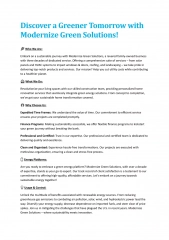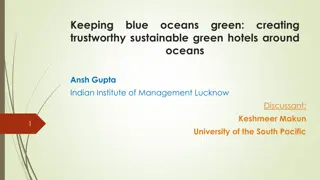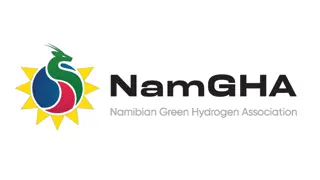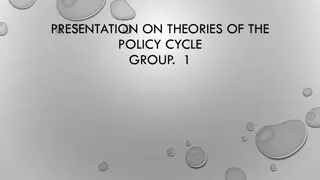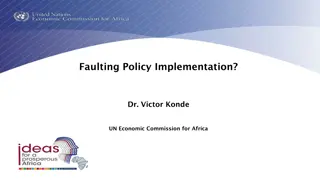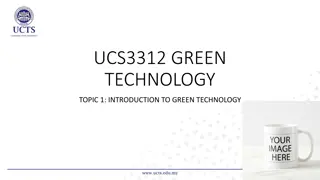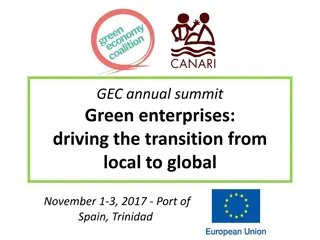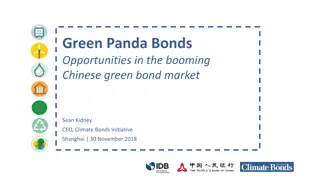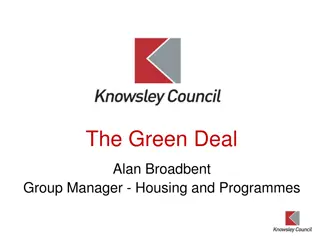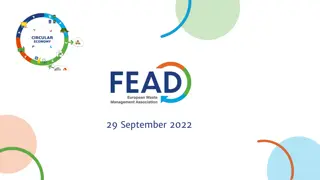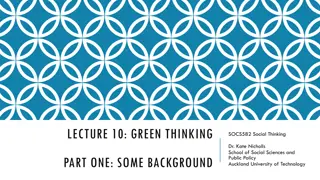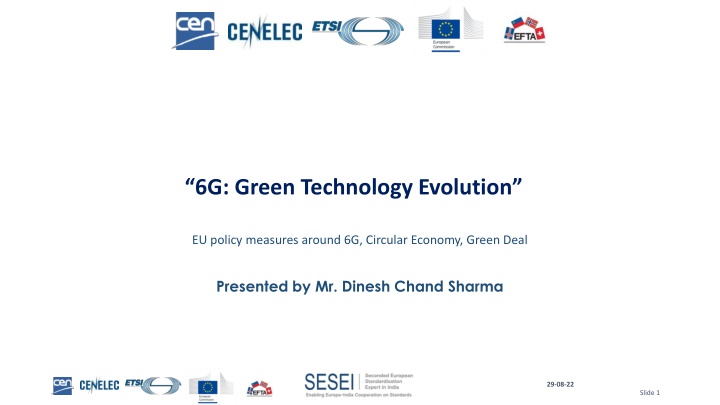
6G Evolution & EU Green Technology Policy Measures
Evolution of 6G technology and EU policy measures around it, including the Circular Economy and Green Deal initiatives. Learn about the European Initiative towards 6G, standards, and the importance of green technology. Presented by Mr. Dinesh Chand Sharma on 29-08-22.
Download Presentation

Please find below an Image/Link to download the presentation.
The content on the website is provided AS IS for your information and personal use only. It may not be sold, licensed, or shared on other websites without obtaining consent from the author. If you encounter any issues during the download, it is possible that the publisher has removed the file from their server.
You are allowed to download the files provided on this website for personal or commercial use, subject to the condition that they are used lawfully. All files are the property of their respective owners.
The content on the website is provided AS IS for your information and personal use only. It may not be sold, licensed, or shared on other websites without obtaining consent from the author.
E N D
Presentation Transcript
6G: Green Technology Evolution EU policy measures around 6G, Circular Economy, Green Deal Presented by Mr. Dinesh Chand Sharma 29-08-22 Slide 1
Agenda About Project SESEI Twin transition green and digital Towards 6G - European Initiative 5G IA White Paper on European Vision for the 6G Network Ecosystem 6G Smart Networks and Services Industry Association (6G-IA) European Green Deal Circular economy action plan Eco-design for Sustainable Products Research & Standards Importance of standards in R&D projects Role of ICT Standards in the Circular Economy Conclusion 29-08-22 2 Slide 2
Project is a permanent presence in India SESEI (Seconded European Standardization Expert in India) is a local face for the European standardization community in India: Dinesh Chand Sharma Why SESEI: India is a major trade partners for Europe, Increasing role of standards to gain market access and Evolving & complex nature of regulatory and standardization landscapes, Sharing best practices, work together Sector: 1. ICT: M2M/IoT, Security, 5G, NFV/SDN, e-Accesibility, eHealth, eCALL 2. Electrical equipment including Consumer Electronics: Smart Grid, Smart Meter, LVDC, Micro- Grid, Lift Escalator 3. Automotive: Connected Cars, ITS, e-Mobility 4. Smart Cities: Mobility, Waste, Energy, ICT and other topics of mutual interests such as Machinery Safety, Cableways, Circular Economy, Railways etc. www.sesei.eu , www.sesei.in , www.eustandards.in 29-08-22 Slide 3
Twin transition green and digital European Commission states that Europe must leverage the potential of digital transformation, which is a key enabler for reaching the Green Deal objectives. 29-08-22 Slide 4
Towards 6G - European Initiative 5G PPP: ICT-52 implementation of 8-6G exploratory projects, 1 flagship= 60 M Strategic Autonomy in critical technology areas EU Industry global competitiveness Full digitalisation of the Industry European Green Deal Industry 6G Partnership Proposal (Smart Networks & Services) https://ec.europa.eu/info/files/european-partnership-smart-networks-and-services_en Accelerating 5G Deployment: CEF2, pan European corridors for Connected Cars 6G Vision and technologies across a comprehensive supply chain 29-08-22 Slide 5
6G Smart Networks and Services Industry Association (6G- IA) Voice of European Industry and Research for next generation networks and services. Contribute to Europe s leadership on 5G, 5G evolution and SNS/6G research. Represents private side in both 5G-PPP and SNS JU Brings together a global industry community of telecoms & digital actors, such as operators, manufacturers, research institutes, universities, verticals, SMEs and ICT associations. Strategic areas including standardization, frequency spectrum, R&D projects, technology skills, collaboration with key vertical industry sectors, notably for the development of trials, and international cooperation. The initiative builds on an EU contribution of 900 million over the next 7 years to be matched by the private sector with the same amount. 29-08-22 Slide 6
5G IA - White Paper on European Vision for the 6G Network Ecosystem 5G IA Vision and Societal Challenges Work Group have published a new White Paper describing a European Vision for the 6G Network Ecosystem . It covers key areas related to 6G research from a technical, societal, policy and business perspective providing a vision for future networks and services. It explains how 6G is expected to play a key role in the evolution of the society towards the 2030 s, as the convergence between the digital, physical and personal worlds will increasingly become a reality. It also presents possible opportunities and obstacles related to 6G as well as a series of recommendations for both policy makers and businesses White Paper is a major milestone at a time when the 5G IA is preparing for the next chapter in the mobile communications story with the new Smart Networks and Services (SNS) - European Partnership in the framework of the Horizon Europe programme. 29-08-22 Slide 7
A European Green Deal In December 2019, European Commission unveiled its European Green Deal (EGD), an ambitious plan to transform the EU s economy into a fair, sustainable, and prosperous one. EGD provides an action plan, to boost efficient use of resources by moving to a clean, circular economy and to restore biodiversity and cut pollution. It outlines investments needed and financing tools available and explains how to ensure an inclusive transition. It covers all sectors of the economy, notably transport, energy, agriculture, buildings, and industries such as steel, cement, ICT, textiles and chemicals. Commission has estimated that achieving 2030 climate and energy targets will require EUR 260 billion of additional annual investment, about 1.5% of 2018 GDP. 29-08-22 Slide 8
Circular economy action plan European Commission released its new Circular Economy Action Plan (CEAP) in support of European Green Deal on 11 March 2020. one of main building blocks of European Green Deal, and new agenda for sustainable growth. 35 actions along the entire life cycle of products, to: make sustainable products the norm in the EU empower consumers and public buyers focus on key product value chains: electronics and ICT, batteries and vehicles, packaging, plastics, textiles, construction and buildings, food, water and nutrients ensure less waste make circularity work for people, regions and cities lead global efforts on circular economy In March 2022, Commission proposed Eco-design for Sustainable Products Regulation and Empowering Consumers for the Green Transition Directive, while a Directive on Sustainable consumption of goods promoting repair and reuse is under preparation. 29-08-22 Slide 9
Eco-design for Sustainable Products Eco-design for Sustainable Products Regulation builds on the existing Eco-design Directive (covers only energy-related products). It establishes a framework for setting up eco-design requirements for specific product groups to significantly improve their circularity, energy performance and other environmental sustainability aspects. Framework will allow for the setting of a wide range of requirements, including on: product durability, reusability, upgradability and repairability presence of substances that inhibit circularity energy and resource efficiency recycled content remanufacturing and recycling carbon and environmental footprints Information requirements, including a Digital Product Passport (provide information about products environmental sustainability. 29-08-22 Slide 10
The Circular Economy package 30 March 2022 29-08-22 Slide 11
Research 29-08-22 Slide 12
Early European 6G research Jan21 Implementation of 1 flagship system project with 8 - 6G exploratory projects of 60M Euro under 5G PPP as a bridging phase into SNS partnership: 5G INNOVATIONS AND BEYOND 5G Hexa-X : Vision and system- New Radio Access Technologies, THz high-resolution localization and sensing; AI applicability, 6G architectural enablers; RISE 6G: Reconfigurable Intelligent Surfaces (RIS) technology for radio wave propagation control, to achieve dynamically programmable wireless environments REINDEER: large-scale intelligent surfaces and cell-free wireless access, distributed radio, computing storage 6G BRAINS: AI based resource allocation in dense IoT environments DEDICAT 6G: Function placement AI/BC based for ultra low latency and security AI@EDGE: secure and automated roll-out of large-scale edge and cloud compute infrastructures DAEMON : optimized radio/computation , energy reduction, high reliability >5X9 MARSAL: Machine learning-based, networking and computing infrastructure resource management of 5G and beyond intelligent networks TeraFlow: Autonomous Networks Beyond 5G, Automotive, and Cybersecurity through Unification of Network and Cloud Resource Management; ML-based security; and Distributed Ledger Technologies B5G-OPEN: design, prototyping and demonstration of a novel end-to-end integrated packet-optical transport architecture based on MultiBand (MB) optical transmission and switching networks 29-08-22 Slide 13
Proposed structure of SNS - R&D work programme 2022 (~ 240M) 29-08-22 Slide 14
Circular cities and regions initiative (CCRI) CCRI was launched by EU as part of Circular Economy Action Plan with an aim to: to support Europe s green transition by boosting circularity at local and regional level. to boost innovation and upscaling, which are essential for making the circular economy more widespread and mainstream. to share replicable best practices to help cities and regions find concrete Circular Systemic Solutions that suit their needs. It also combines knowledge-sharing with financial support and technical support, including: financial support to demonstration projects from Horizon Europe ( 200 million over six years); financial support to project development assistance (PDA) of investment proposals 40-50 million depending on needs, as part of Horizon Europe and Circular Economy Technical Assistance Facility (CETAF) grants from the European Investment Bank; non-financial assistance from collaborating organisations, such as European Investment Bank s Circular City Centre (C3), and the Organisation for Economic Co-operation and Development (OECD) Programme on the Circular Economy in Cities and Regions . 29-08-22 Slide 15
Importance of standards in R&D projects 29-08-22 Slide 16
Why Standards are important for R&D Projects Why include standardization in your research project? Standardization helps bridging the gap between research and the market, by enabling the fast and easy transfer of research results to market Engaging in Standards groups at the appropriate stages of R&I cycles is crucial to the development of new and evolved technologies. ETSI s 8-point plan for Researchers: Allocate Budget for Standardization Develop a Standards Landscape Compare Schedules and Workplans Identify Research Topics for Standards Identify SDOs for Research Topics Identify Project Partners Develop a Standards Action Plan Track Standards Activities and Impacts Flowchart shows possible options for project proposers interested in including standardization in their project. 29-08-22 Slide 17
Standardization 29-08-22 Slide 18
ETSI approach to B5G/6G Research & Standards Operators are currently deploying 5G networks across the globe. 170 commercial 5G networks have already been launched covering 70% of the world population. (source: GSMA Nov. 2021) It is important to use with caution when using the term 6G to avoid diluting the impact of present day 5G rollouts. In ETSI we speak only of Research and pre-standards work for candidate B5G/6G technologies. Current assumption is that the first 6G services may be deployed as of 2030 but of course expectations can and often do change due to global/market pressure. 6G is currently at the Vision & Research phase. Initial study items for 6G are not expected to be seen in 3GPP (SA1) until > 2025/2026. 5G evolution and 6G developments will run as parallel tracks for several years 29-08-22 Slide 19
Role of ICT Standards in the Circular Economy 29-08-22 Slide 20
ICT Standardization supporting Circular Economy Rethinking of processes, production, development, lifecycle etc. will require significant changes to how things are done today. ICT standards play an important role in identifying, capturing, collecting and sharing data, classifying the data, providing data formats, transferring data through different infrastructure levels, analysing data, providing it for making use of it. support tools to work with data as well as tools for design. define methods as well as metrics, e.g for testing and benchmarking. lay down rules for data governance and many more areas. key objectives to drive the changes: Circular design: Digital tools improving both products and processes. Value chain coordination: Reducing transaction costs, enabling reverse logistics, brokerage and collaborative systems, better service information for consumers, product identification and information for repairers and recyclers or smart legal framing of co-operations and data sharing. More efficient asset use: Digital technologies can enable platforms and tracking for asset sharing or re-use, and for providing products-as-a-service. More material efficiency: Ex. input cost reduction through precision farming and manufacturing, data and systems to ensure higher quality of secondary raw materials. Virtualisation to dematerialise products Waste reduction Source: ICT Standardisation supporting Circular Economy (standict.eu) 29-08-22 Slide 21
Circular Economy in ICT networks ETSI Technical Committee on Environmental Engineering (ETSI TC EE): develops standards for reducing the eco-environmental impact of Information and Communications Technologies (ICT) equipment. TR 103 476 (V1.1.1, 01/2017) is an analysis of the current approaches, concepts and metrics of CE and RE and their applicability for ICT infrastructure goods. 1. introduces CE and RE, 2. describes CE as used in the ICT industry, 3. describes existing CE and RE metrics and examples of their use, 4. proposes next steps in CE and RE standardization. TR includes the aspects of upgradability, reparability, removability, durability, reusability, recyclability, recoverability, refurbishability, manufacturability Indicators and metrics are defined for recycled content, use of critical raw materials, proportion of reused parts It s a technical aligned technical report/standard with ITU-T SG5 publication 29-08-22 Slide 22
Continue CEN/CLC/TC 10 - Material Efficiency Aspects for Ecodesign General standards for Circular Economy aspects have been published by CEN/CENELEC JTC10 EN 45552:2020 General method for the assessment of the durability of energy-related products. EN 45553: 2020 General method for the assessment of the ability to remanufacture energy-related products. EN 45554:2020 General methods for the assessment of the ability to repair, reuse and upgrade energy- related products. EN 45555:2019 General methods for assessing the recyclability and recoverability of energy-related products. EN 45556:2019 General method for assessing the proportion of reused components in energy-related products. EN 45557:2020 General method for assessing the proportion of recycled material content in energy- related products. EN 45558:2019 General method to declare the use of critical raw materials in energy-related products EN 45559:2019 Methods for providing information relating to material efficiency aspects of energy-related products. TR 45550:2020 Definitions related to material efficiency 29-08-22 Slide 23
ETSI standards adopted in eco-design Regulations /Directives Directive 2009/125/EC (21 October 2009) on eco-design and associated implementing measures Implementing measures affecting ICTs Simple set-top boxes regulation No 107/2009 ; External power supplies regulation No 278/2009 ; Televisions regulation No 642/2009 ; Standby and Off Modes regulation No 1275/2008 (17 December 2008) Networked Standby regulation No 801/2013 (22 August 2013) amending regulation No 1275/2008 ETSI EN 303 423 Electrical and electronic household and office equipment; Measurement of networked standby power consumption of Interconnecting equipment Servers and data storage product EU 2019/424 ETSI, in cooperation with CEN/CENELEC, is producing standards for: energy efficiency (i.e. revision of EN 303 470), secure data deletion, availability of firmware and security updates to firmware, critical raw material, disassembly Material Efficiency Mandate M/543 ETSI is in charge of the standard for ICT network infrastructure goods Mandate 462 on Standardization in the field of ICT to enable efficient energy use in fixed and mobile information and communication networks Addressed to improve the energy efficiency of the provider infrastructure to counterbalance the growth in telecommunications networks End user equipment are not in the scope of this mandate ETSI has produced the standards for this mandate (TC-EE produced the standards to measure energy efficiency, TC-ATTM produced the standard for the operationalKPIs energy efficiency of sites/networks) Code of Conducts (https://publications.jrc.ec.europa.eu/repository/handle/JRC106039) Energy Consumption of Broadband Communication Equipment ETSI standard for measurement methods have been adopted Data Centres Energy Efficiency Environmental classes defined in ETSI standard EN 300 019 series have been adopted Digital TV Services ; Efficiency of External Power Supplies ; AC Uninterruptible Power Systems 29-08-22 Slide 24
CEN-CENELEC Ecodesign Coordination Group (Eco-CG) In order to coordinate and advise on standardization activities in the fields of Ecodesign and Energy Labelling, the CEN and CENELEC Technical Boards set up in November 2012 the CEN-CENELEC Ecodesign Coordination Group (Eco-CG). It serves as a focal point concerning standardization issues relating to the Ecodesign Standardization Requests delivered under Directive 2009/125/EC on Ecodesign of energy-related products and Regulation (EU) 2017/1369 on Energy Labelling of energy-related products and their future versions. 25 Technical Committees actively involved (e.g. CLC/TC 59X, CLC/TC 22X, CLC/TC 34, CLC/TC 100X, CLC/TC 2, CLC/TC 14, etc.) 180 published European standards (ENs) & 50 under development Products covered by CEN and CENELEC - To be expanded based on EC s Ecodesign Working Plans: Vacuum cleaners External power supplies Simple set top boxes Refrigerating appliances Circulators Electric motors Variable speed drives Televisions Dishwashers Washing machines Lamps Air conditioners Power transformers Electrical lamps Professional refrigeration Fans Water heaters Space heaters Ventilation units Networked standby Computers and computer servers Non-household washing machines, dryers and dishwashers Local space heaters Solid fuel boilers Welding equipment Refrigerated commercial display cabinets Air heating, cooling and high temperature process chillers Tumble dryers etc. https://www.cencenelec.eu/areas-of-work/cen-cenelec-topics/ecodesign-energy-labelling-and-material- efficiency/ecodesign-and-energy-labelling/ 29-08-22 Slide 25
Conclusion Early 6G expected around 2030 alongside an evolved 5G. Now is the time to share 6G visions, research and standards roadmaps. ETSI has an important role to play in linking the research and pre-standards in order to feed the global 6G standards activities in 3GPP We must make use of European/international standards to support the Circular economy actions and initiatives, to benefit from the knowledge of industry experts, SMEs as well as environment organizations to decarbonize sectors through the wide-spread use of standards in the market. 29-08-22 Slide 26
Dinesh Chand Sharma (Seconded European Standardization Expert in India) Director Standardization & Public Policy SESEI C/O EBTC, DLTA Complex, Gate No 3, 1st Floor, 1, Africa Avenue, New Delhi 110029 Mobile: +91 9810079461, Tel: +91 11 3352 1525, dinesh.chand.sharma@sesei.eu www.sesei.eu www.sesei.in 29-08-22 Slide 27

